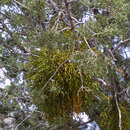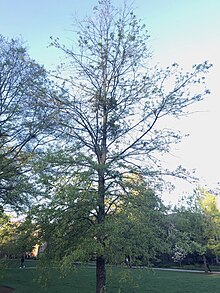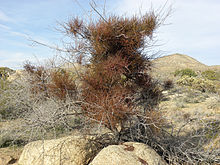pt-BR
nomes no trilho de navegação


Mistletoe is a parasitic plant, meaning that it needs a host plant in order to live. In the Sonoran Desert, these host plants are usually Mesquite Trees and Palo Verde Trees. Mistletoe gets all of its nutrients from the host plant, which leads to the stunted growth of the host plant, lost of limbs, and in some cases, the death of the host plant. Mistletoe has small leaves and it has juicy stems. It produces white and pink berries that birds eat. It is able to reproduce when birds eat the berries and then fly to another suitable host tree and defecate, spreading the seeds of the berries. Despite harming its host plant, many different species of animals actually rely on the Mistletoe plant for food.
Phoradendron ist eine Pflanzengattung innerhalb der Familie der Sandelholzgewächse (Santalaceae). Die etwa 240 Arten sind in der Neuen Welt weitverbreitet. Diese parasitische Pflanzen wachsen auf Bäumen.
Phoradendron-Arten sind verholzende Sträucher, die hemiparasitisch[1] auf Bäumen wachsen. Als Wirtspflanzen kommen Nadel- und Laubbäume in Frage. Manche Arten sind auf einzelne Wirtsbaumarten spezialisiert, viele können jedoch ein weites Spektrum verschiedener Baumarten befallen. Ihre Zweige werden je nach Art 10 bis 80 Zentimeter lang; sie verzweigen dichotom.
Die gegenständigen Blätter sind bei manchen Arten 2 bis 5 cm lang, bei anderen wie Phoradendron californicum dagegen sehr klein. Die Pflanzen betreiben Photosynthese, ziehen aber Nährstoffe und Wasser aus der Wirtspflanze. Das unter der Rinde der Wirtspflanze verborgene Wurzelsystem kann auch ohne die sichtbaren Pflanzenteile weiterleben.
Phoradendron-Arten sind zweihäusig (diözisch), es gibt also männliche und weibliche Pflanzenexemplare. Die Blüten sind klein und unscheinbar; sie sind grüngelb und 1 bis 3 mm groß. Männliche und weibliche Blüten sind vom Aussehen so ähnlich, dass das Geschlecht eines Pflanzenexemplars oft erst zur Zeit des Fruchtansatzes erkennbar ist.
Die Früchte sind Beeren, die je nach Art im reifen Zustand die Farben weiß, gelb, orange oder rot annehmen. Im sehr klebrigen Fruchtfleisch befinden sich mehrere Samen.
Die Chromosomengrundzahl beträgt x = 14.[1]
Die Ausbreitung der Samen geschieht über Vögel wie den Zedernseidenschwanz (Bombycilla cedrorum) und den Trauerseidenschnäpper (Phainopepla nitens).
Die Gattung Phoradendron wurde 1848 durch Thomas Nuttall in Journal of the Academy of Natural Sciences of Philadelphia, Second Series, 1, 2, Seite 185–186 aufgestellt. Der Gattungsname Phoradendron setzt sich aus den griechischen Wörtern phor für Dieb und dendron für Baum zusammen, dies bezieht sich auf den Parasitismus.[1] Als Lectotypus-Art wurde 1913 Phoradendron californicum Nutt. durch Nathaniel Lord Britton in Addison Brown: An Illustrated Flora of the Northern United States, 2. Auflage, 1, Seite 639 festgelegt.[2] Synonyme für Phoradendron Nutt. sind Allobium Miers, Baratostachys (Korth.) Kuntze, Baratostachys Uphof, Spiciviscum Engelm. ex A.Gray, Spiciviscum H.Karst., Viscum sect. Baratostachys Korth., Baratostachys sect. Phorodendrum (Nutt.) Kuntze.[2][3]
Früher wurde die Gattung Phoradendron in eine eigene Familie Viscaceae gestellt. Molekulargenetische Forschungsergebnisse haben gezeigt, dass diese Gattung in die Familie der Sandelholzgewächse (Santalaceae) zu stellen ist.
Phoradendron-Arten sind in den tropischen bis warm-gemäßigten Gebieten der Neuen Welt verbreitet. Sie sind von den USA über Mexiko, Zentralamerika und Karibischen Inseln bis Südamerika weitverbreitet.[1]
In der Gattung Phoradendron gibt es etwa 240 Arten. Hier eine Artenauswahl:[4]
Blätter und Beeren einiger Arten der Gattung Phoradendron sind giftig.
Phoradendron ist eine Pflanzengattung innerhalb der Familie der Sandelholzgewächse (Santalaceae). Die etwa 240 Arten sind in der Neuen Welt weitverbreitet. Diese parasitische Pflanzen wachsen auf Bäumen.
Phoradendron is a genus of mistletoe, native to warm temperate and tropical regions of the Americas. The center of diversity is the Amazon rainforest.[3] Phoradendron is the largest genus of mistletoe in the Americas, and possibly the largest genus of mistletoes in the world.[4] Traditionally, the genus has been placed in the family Viscaceae, but recent genetic research acknowledged by the Angiosperm Phylogeny Group shows this family to be correctly placed within a larger circumscription of the sandalwood family, Santalaceae.
They are woody hemi-parasitic shrubs with branches 10–80 cm (3.9–31.5 in) long, which grow on other trees. The foliage is dichotomously branching, with opposite pairs of leaves; these are fairly large, 2–5 cm (0.79–1.97 in) long, green and photosynthetic in some species (e.g. P. leucarpum), but minimal in some others (e.g. P. californicum). Although they are able to photosynthesize the plant relies on its host for some nutrients. The plant draws its mineral and water needs, and some of its energy needs, from the host tree using a haustorium which grows into the stems of the host.[5]
The flowers are inconspicuous and incomplete, no petals and 3-4 greenish-yellow sepals,[6] 1–3 mm (0.039–0.118 in) diameter. The fruit is a berry, white, yellow, orange, or red when mature, containing one to several seeds embedded in very sticky juice, called viscin.[4] The flowers are unisexual, and depending on the species, the plant will be monoecious or dioecious (both male and female flowers on a single plant or male and female plants with only one sex of flowers).[4] The seeds are dispersed when birds eat the fruit and remove the sticky seeds from their bills by wiping them on tree branches where they can germinate.
The foliage and berries of some species are toxic. Leafy mistletoes seldom kill but they cause stress reducing crop productions in fruits and nut trees.[7]
Phoradendron plants can be distinguished from mistletoes in other genera in Viscaceae by their inflorescences, which lack leaves and come from a single branching point or apical meristem.[4] However, it can be difficult to identify species within Phoradendron, because leaf shape and color can vary greatly even within species.[6]
Phoradendron species can infest many taxa of plants including hackberry (Celtis spp.) mesquite (Prosopsis spp.), cedar, elm (Ulmus spp.), and Osage-orange.[8] Certain species of Phoradendron are host-specific; for example, in Arizona, Phoradendron tomentosum infests cottonwood (Populus fremontii), sycamore (Platanus wrightii), ash (Fraxinus spp.), walnut (Juglans spp.) and willow (Salix spp.).[9] P. californicum infests shrubs and trees such as acacia (Acacia spp.) and blue palo verde (Parkinsonia florida). Some species infest junipers (Juniperus spp.) and oaks (Quercus spp.).[10] Branches often become swollen and distorted, forming burls and making the tree more susceptible to insect attack.[8] Phoradendron presents serious problems along rivers, streams, parks, and golf courses with large cottonwood trees. Deciduous trees can be mistaken for evergreens during the winter if infection is heavy.[10] Other common symptoms include swelling formations of witch's broom, dieback, and weakened branches.[11]
Phoradendron species are hemiparasites which produce their own chlorophyll but rely on the host plant to provide water, minerals, and other nutrients.[12] Birds are the primary means of dispersal of the parasite.[13] Birds consume the drupes of the mistletoe and excrete or regurgitate the seeds onto the branches of the host plant. The seeds do not need to be ingested to germinate. Germinating seeds produce a radicle, a holdfast, and eventually the germinated seeds produce haustoria. The haustorium is a root-like structure that penetrates the host plant's bark and cambium, reaching the xylem and phloem where it extracts water and minerals, primarily carbon and nitrogen compounds. A study on the nutrient ratio between Phoradendron and their hosts found that the parasite have higher concentrations of nitrogen and minerals, especially in leguminous hosts. This suggests that the parasite actively draws nutrients from the host plant through both the xylem and phloem, challenging the alternative theory of the passive uptake of nutrients by the parasite from the host xylem only.[14] The most important birds for effective dispersal include the cedar waxwing, euphonias, silky-flycatchers, bluebirds, and thrushes.[9]
Leafy mistletoe can adversely affect trees growing in urban environments and in forests.[12] It is considered a nuisance in urban environments because of its appearance on deciduous trees during winter. Severe colonization of mistletoe can affect the health of an individual tree, and a tree already stressed by other factors can be killed. Forest fragmentation can increase Phoradendron infection rates in some oak trees, as trees in lower density forests and those closer to the forests' edges are more likely to be colonized by the mistletoe.[15] Control and management regimes include watering the host plant to improve its vigor, and removing infested vegetation. Pruning infested branches is not generally effective because the haustoria can infiltrate deeply. Plucking the mistletoe herbage is a temporary treatment because it easily resprouts, but keeping its herbage sparse can help to reduce its seed production.[9]
Phoradendron species are larval host plants for a number of Lepidoptera. The buckthorn duskywing (Erynnis pacuvius) feeds on Phoradendron californicum.[16]
Phoradendron are the preferred food of the Phainopepla, a silky-flycatcher. The male defends territories where fruiting mistletoe is abundant.[17]
There may actually be some mutualistic interactions between the parasite and the host in some Phoradendron species. The presence of Phoradendron juniperinum on host Juniperus monosperma, for example, has been suggested to increase dispersal of the host's seeds by birds. The mistletoe berries may attract frugivorous birds (e.g. thrushes) to eat the host juniper's seeds and disperse them. The net benefit on the hosts is difficult to quantify, however. The birds dispersing the host's seeds and benefiting the host, while at the same time dispersing the mistletoe's seeds and spreading the Phoradendron infection.[18]
Phoradendron californicum was used by Native American peoples as a food and medicinal remedy.[19]
Some Phoradendron species, such as Phoradendron serotinum and Phoradendron flavescens, are used in North America as Christmas decoration, substituting for the European mistletoe Viscum album.[20] They are harvested commercially for that purpose.
Nuttall named the genus Phoradendron from the Greek, phor (a thief) and dendron (tree), alluding to the genus' parasitic habit.[2]
There are roughly 235[3] to 240[21] species in the genus.
Species include:[22][23][24][25]
 Phoradendron strongyloclados showing leathery leaves and an inflorescence resulting from one apical meristem.
Phoradendron strongyloclados showing leathery leaves and an inflorescence resulting from one apical meristem.  Phoradendron macrophylla in Arizona sycamore
Phoradendron macrophylla in Arizona sycamore Multiple Phoradendron individuals parasitizing an oak tree. While lower branches show new leaf growth, the mistletoe appears to be negatively affecting the tree's budding in the upper branches.
Multiple Phoradendron individuals parasitizing an oak tree. While lower branches show new leaf growth, the mistletoe appears to be negatively affecting the tree's budding in the upper branches.  Phoradendron californicum (Desert Mistletoe), Granite Mountains, Mojave Desert, California
Phoradendron californicum (Desert Mistletoe), Granite Mountains, Mojave Desert, California Phoradendron is a genus of mistletoe, native to warm temperate and tropical regions of the Americas. The center of diversity is the Amazon rainforest. Phoradendron is the largest genus of mistletoe in the Americas, and possibly the largest genus of mistletoes in the world. Traditionally, the genus has been placed in the family Viscaceae, but recent genetic research acknowledged by the Angiosperm Phylogeny Group shows this family to be correctly placed within a larger circumscription of the sandalwood family, Santalaceae.
They are woody hemi-parasitic shrubs with branches 10–80 cm (3.9–31.5 in) long, which grow on other trees. The foliage is dichotomously branching, with opposite pairs of leaves; these are fairly large, 2–5 cm (0.79–1.97 in) long, green and photosynthetic in some species (e.g. P. leucarpum), but minimal in some others (e.g. P. californicum). Although they are able to photosynthesize the plant relies on its host for some nutrients. The plant draws its mineral and water needs, and some of its energy needs, from the host tree using a haustorium which grows into the stems of the host.
The flowers are inconspicuous and incomplete, no petals and 3-4 greenish-yellow sepals, 1–3 mm (0.039–0.118 in) diameter. The fruit is a berry, white, yellow, orange, or red when mature, containing one to several seeds embedded in very sticky juice, called viscin. The flowers are unisexual, and depending on the species, the plant will be monoecious or dioecious (both male and female flowers on a single plant or male and female plants with only one sex of flowers). The seeds are dispersed when birds eat the fruit and remove the sticky seeds from their bills by wiping them on tree branches where they can germinate.
The foliage and berries of some species are toxic. Leafy mistletoes seldom kill but they cause stress reducing crop productions in fruits and nut trees.
Phoradendron plants can be distinguished from mistletoes in other genera in Viscaceae by their inflorescences, which lack leaves and come from a single branching point or apical meristem. However, it can be difficult to identify species within Phoradendron, because leaf shape and color can vary greatly even within species.
 Phoradendron sp. on Spanish oak
Phoradendron sp. on Spanish oak
Phoradendron es un género con 491 especies de plantas de flores perteneciente a la familia Santalaceae. Anteriormente se clasificaba dentro de la familia Viscaceae.
Phoradendron es un género con 491 especies de plantas de flores perteneciente a la familia Santalaceae. Anteriormente se clasificaba dentro de la familia Viscaceae.
Le genre Phoradendron regroupe des espèces de gui originaires des régions tempérées chaudes et tropicales d'Amérique. Traditionnellement, le genre était placé dans sa propre famille, les Viscaceae, mais des recherches génétiques récentes réalisées par l'Angiosperm Phylogeny Group montrent que cette famille doit être placée dans la famille des bois de santal, les Santalaceae. L'espèce type est Phoradendron californicum Nutt.
Ce sont des arbustes hémiparasites semi-ligneux avec des branches de 10 à 80 cm de longueur, qui poussent sur d'autres arbres. Le feuillage est à ramification dichotomique, avec des feuilles opposées, assez grandes, de 2 à 5 centimètres de longueur, vertes et capables de photosynthèse chez certaines espèces (par exemple, P. leucarpum), mais minime chez d'autres (par exemple P . californicum). La plante puise ses ressources minérales son eau et certains de ses composés énergétiques de l'arbre hôte. Les différentes espèces de Phoradendron ont tendance à utiliser différentes espèces hôtes, même si la plupart des espèces sont capables d'utiliser plusieurs hôtes différents.
Les fleurs sont très discrètes, jaune verdâtre, de 1 à 3 millimètres de diamètre. Le fruit est une baie, blanche, jaune, orange ou rouge à maturité, contenant plusieurs graines incorporées dans un jus très collant, les graines sont dispersées lorsque les oiseaux (notamment les Jaseurs d'Amérique et les Phénopèples luisants) en mangeant les fruits, retirent les graines du jus et s'essuient le bec sur les branches où les graines peuvent germer.
Le feuillage et les fruits de certaines espèces sont toxiques.
Selon GBIF (04 février 2022)[2] :
Selon World Flora Online (WFO) (04 février 2022)[3] :
Baies de Phoradendron californicum
Baies de Phoradendron villosum
Le genre Phoradendron regroupe des espèces de gui originaires des régions tempérées chaudes et tropicales d'Amérique. Traditionnellement, le genre était placé dans sa propre famille, les Viscaceae, mais des recherches génétiques récentes réalisées par l'Angiosperm Phylogeny Group montrent que cette famille doit être placée dans la famille des bois de santal, les Santalaceae. L'espèce type est Phoradendron californicum Nutt.
Ce sont des arbustes hémiparasites semi-ligneux avec des branches de 10 à 80 cm de longueur, qui poussent sur d'autres arbres. Le feuillage est à ramification dichotomique, avec des feuilles opposées, assez grandes, de 2 à 5 centimètres de longueur, vertes et capables de photosynthèse chez certaines espèces (par exemple, P. leucarpum), mais minime chez d'autres (par exemple P . californicum). La plante puise ses ressources minérales son eau et certains de ses composés énergétiques de l'arbre hôte. Les différentes espèces de Phoradendron ont tendance à utiliser différentes espèces hôtes, même si la plupart des espèces sont capables d'utiliser plusieurs hôtes différents.
Les fleurs sont très discrètes, jaune verdâtre, de 1 à 3 millimètres de diamètre. Le fruit est une baie, blanche, jaune, orange ou rouge à maturité, contenant plusieurs graines incorporées dans un jus très collant, les graines sont dispersées lorsque les oiseaux (notamment les Jaseurs d'Amérique et les Phénopèples luisants) en mangeant les fruits, retirent les graines du jus et s'essuient le bec sur les branches où les graines peuvent germer.
Le feuillage et les fruits de certaines espèces sont toxiques.
Phoradendron é um género botânico pertencente à família Santalaceae.[1]
Phoradendron é um género botânico pertencente à família Santalaceae.
Phoradendron là một loài Magnoliopsida trong họ Viscaceae. Loài này được miêu tả khoa học đầu tiên năm.[1]
Đây là loài gây hại của các cây trong chi Quercus, phát triển phổ biến ở Mexico.
Phoradendron là một loài Magnoliopsida trong họ Viscaceae. Loài này được miêu tả khoa học đầu tiên năm.
Đây là loài gây hại của các cây trong chi Quercus, phát triển phổ biến ở Mexico.